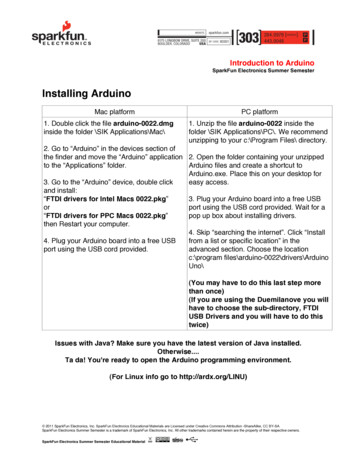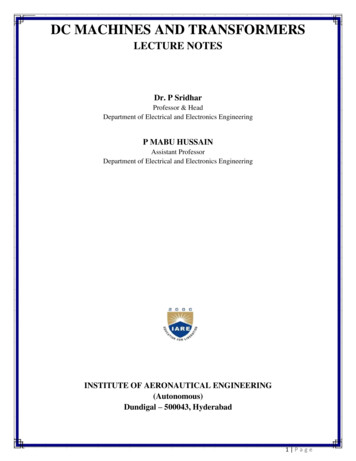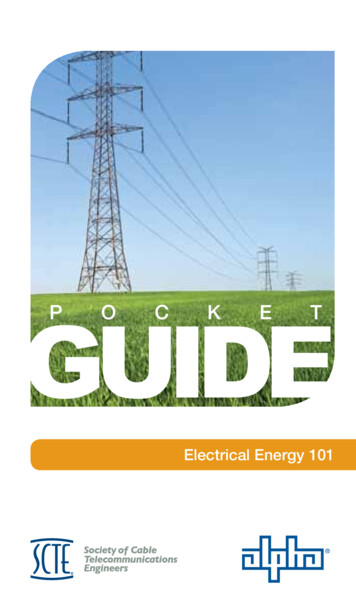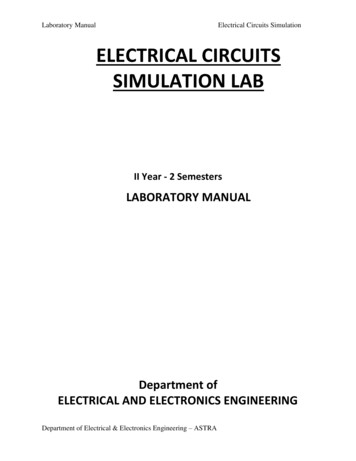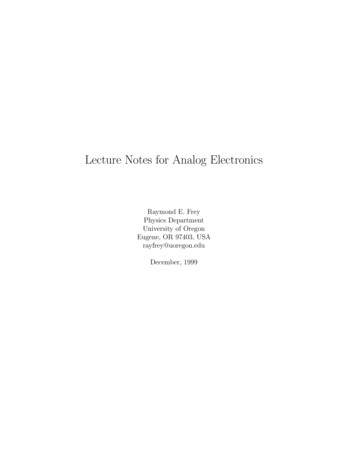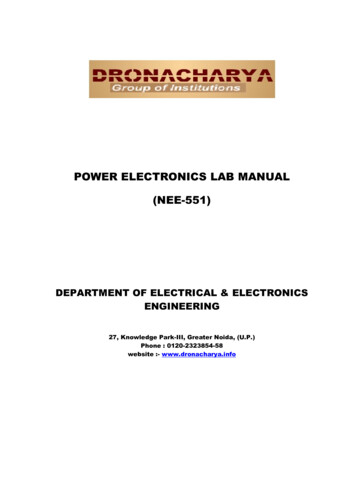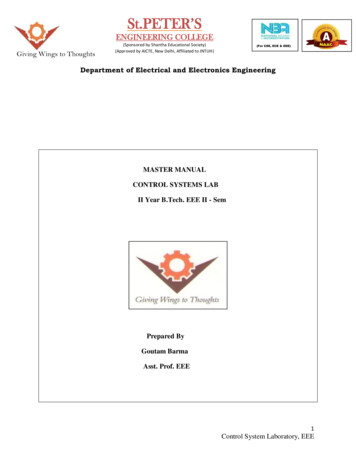
Transcription
St.PETER’SENGINEERING COLLEGEGiving Wings to Thoughts(Sponsored by Shantha Educational Society)(Approved by AICTE, New Delhi, Affiliated to JNTUH)(For CSE, ECE & EEE)Department of Electrical and Electronics EngineeringMASTER MANUALCONTROL SYSTEMS LABII Year B.Tech. EEE II - SemPrepared ByGoutam BarmaAsst. Prof. EEE1Control System Laboratory, EEE
St.PETER’SENGINEERING COLLEGEGiving Wings to Thoughts(Sponsored by Shantha Educational Society)(Approved by AICTE, New Delhi, Affiliated to JNTUH)(For CSE, ECE & EEE)Department of Electrical and Electronics EngineeringINDEXSl. No12Experiment NameCHARACTERISTICS OF SYNCHRO TRANSMITTER ANDRECEIVER PAIRCHARACTERISTICS OF AC SERVOMOTORPage No.39153EFECT OF FEEDBACK ONDC SERVOMOTOR4TEMPERATURE CONTROL USING PID195TIME RESPONSE OF SECOND ORDER SYSTEM22276PROGRAMMABLE LOGIC CONTROLLER7ROOT LOCUS PLOT, BODE PLOT USING MATLAB.368STATE SPACE MODEL FOR A GIVEN CLASSICAL TRANSFERFUNCTION429TRANSFER FUNCTION OF DC GENERATOR4510TRANSFER FUNCTION OF DC MOTOR4911EFFECT OF P, PI AND PID CONTROLLER ON54A SECOND ORDER SYSTEM12LAG AND LEAD COMPENSATION MAGNITUDE AND PHASE PLOT582Control System Laboratory, EEE
St.PETER’SENGINEERING COLLEGEGiving Wings to Thoughts(Sponsored by Shantha Educational Society)(Approved by AICTE, New Delhi, Affiliated to JNTUH)(For CSE, ECE & EEE)Department of Electrical and Electronics EngineeringEXPERIMENT NO.1CHARACTERISTICS OF SYNCHRO TRANSMITTER ANDRECEIVER PAIRAIM: a) To study the characteristics of synchro Transmitter.b) To study the characteristics of synchro transmitter and receiver pair.APPARATUS:1. Synchro Transmitter and receiver pair trainer kit.2. Patch cords.Characteristics of Synchro Transmitter.CIRCUIT DIAGRAM:3Control System Laboratory, EEE
St.PETER’SENGINEERING COLLEGE(Sponsored by Shantha Educational Society)(Approved by AICTE, New Delhi, Affiliated to JNTUH)Giving Wings to Thoughts(For CSE, ECE & EEE)Department of Electrical and Electronics EngineeringPROCEDURE:1. Connect the main supply to the system with the help of cable provided. Do not connectany patch cords to terminals marked S1, S2, and S3.2. Switch on mains supply for the unit.3. Starting from zero position, note down the voltage between stator winding terminals i.e.VS1 S2, VS2 S3, and VS3 S1 in a sequential manner. Enter readings in a tabular form andplot a graph of angular manner. Enter readings in tabular form and plot a graph of angularposition of rotor vs. stator voltages for all three phases.4. Note that zero position of the stator, rotor coincides with VS 3 S1 voltage equal to zerovoltage. Don’t disturb this condition.OBSERVATIONS:Sl.No.1Rotor position 233013360STATOR TERMINAL VOLTAGEVS3S1VS1S2VS2S34Control System Laboratory, EEE
St.PETER’SENGINEERING COLLEGEGiving Wings to Thoughts(Sponsored by Shantha Educational Society)(Approved by AICTE, New Delhi, Affiliated to JNTUH)(For CSE, ECE & EEE)Department of Electrical and Electronics EngineeringMODEL GRAPH:Study of synchro transmitter & receiver pairCIRCUIT DIAGRAM:5Control System Laboratory, EEE
St.PETER’SENGINEERING COLLEGEGiving Wings to Thoughts(Sponsored by Shantha Educational Society)(Approved by AICTE, New Delhi, Affiliated to JNTUH)(For CSE, ECE & EEE)Department of Electrical and Electronics Engineering6Control System Laboratory, EEE
St.PETER’SENGINEERING COLLEGEGiving Wings to Thoughts(Sponsored by Shantha Educational Society)(Approved by AICTE, New Delhi, Affiliated to JNTUH)(For CSE, ECE & EEE)Department of Electrical and Electronics EngineeringPROCEDURE:1. Connect the mains supply with the help of cable provided.2. Connect S1, S2 and S3 terminals of transmitter to S′1, S′2 and S′3 of synchro receiver bypatch cords provided respectively.3. Main supply Switch on transmitter and reciever and also switch on the.4. Move the pointer i.e. rotor position of synchro transmitter Tx in steps of 300 and observethe new rotor position on receiver side which follows its both the directions of rotationsand their positions are in good agreement.5. Enter the input angular position and output angular position in the tabular form and plot agraph.OBSERVATIONS:S.NoTransmitter Rotorangle ( deg er Rotorangle ( deg )7Control System Laboratory, EEE
St.PETER’SENGINEERING COLLEGEGiving Wings to Thoughts(Sponsored by Shantha Educational Society)(Approved by AICTE, New Delhi, Affiliated to JNTUH)(For CSE, ECE & EEE)Department of Electrical and Electronics Engineering12360MODEL GRAPH :RESULT:VIVA QUESTIONS:1. Define synchro transmitter?2. Define synchro receiver?3. What are applications of synchro transmitter and receiver?4. where it is used?5. Explain Working Principle of synchro transmitter and receiver?6. Draw the Ckt of synchro transmitter and receiver?7. How it is useful to do this experiment8. Write the terminal Voltages of the stator for Synchro Transmitter?9. What is a synchro?10. What are the names of synchros?8Control System Laboratory, EEE
St.PETER’SENGINEERING COLLEGEGiving Wings to Thoughts(Sponsored by Shantha Educational Society)(Approved by AICTE, New Delhi, Affiliated to JNTUH)(For CSE, ECE & EEE)Department of Electrical and Electronics EngineeringEXPERIMENT NO. 2CHARACTERISTICS OF AC SERVOMOTORAIM: To study the Characteristics of AC Servomotor & to draw its Speed – TorqueCharacteristics.APPARATUS:1. AC Servo Motor Unit2. MultimeterCIRCUIT DIAGRAM:9Control System Laboratory, EEE
St.PETER’SENGINEERING COLLEGEGiving Wings to Thoughts(Sponsored by Shantha Educational Society)(Approved by AICTE, New Delhi, Affiliated to JNTUH)(For CSE, ECE & EEE)Department of Electrical and Electronics EngineeringSPEED Vs BACK EMF CHARACTERISTICS:PROCEDURE:1. Study all the labels on the front panel carefully.2. Initially keep load and servo motor switch at OFF position.3. Keep P1 (load control knob of DC motor) and P2 (speed control knob of ac servo motor)at minimum position.4. Now switch ON main supply to the unit and also AC Servo Motor supply switch.5. With load switch in OFF position vary the speed of AC Servo Motor by moving thecontrol voltage. This is done by varying the knob P2.6. For different speed note down back e.m.f (in mili-volt) generated by DC motor at TP1terminal using DMM.7. Bring P1 and P2 to minimum position. Switch of the servomotor and the main supply tothe kit.8. Plot the graph speed Vs back emfTABULATION:Sl. No.Speed (RPM)15502650375048505950Back emf (mili-volt)10Control System Laboratory, EEE
St.PETER’SENGINEERING COLLEGEGiving Wings to Thoughts(Sponsored by Shantha Educational Society)(Approved by AICTE, New Delhi, Affiliated to JNTUH)(For CSE, ECE & EEE)Department of Electrical and Electronics EngineeringMODEL GRAPH:SPEED Vs TORQUE CHARACTERISTICS:PROCEDURE:1. Switch ON the supply to the kit and also switch ON the servomotor. Keep the load switchat OFF position2. Vary P2 to set the control winding at Vc1 45V. This voltage can be measured by usingDMM at the terminals labeled “Control winding voltage” on the front panel ofservomotor kit.3. Vary the load control knob P1 in steps and in each step note down the back emf, armaturecurrent and speed.4. Vary P2 to set the control winding at Vc2 50V and Vc3 55V and repeat the step 3.6. Bring P1 to its minimum position and then bring P2 to its minimum position. Switch OFFload, servomotor and main supply switch on by one.5. Calculate the power and torque and plot the speed Vs torque characteristic of motor.11Control System Laboratory, EEE
St.PETER’SENGINEERING COLLEGE(Sponsored by Shantha Educational Society)(Approved by AICTE, New Delhi, Affiliated to JNTUH)Giving Wings to Thoughts(For CSE, ECE & EEE)Department of Electrical and Electronics EngineeringTABULATION:Vc1 0.5SpeedN(rpm)Eb(mV)Power(mW)T(N-m)Vc2 peedN(rpm)Eb(mV)Power(mW)T(N-m)12Control System Laboratory, EEE
St.PETER’SENGINEERING COLLEGE(Sponsored by Shantha Educational Society)(Approved by AICTE, New Delhi, Affiliated to JNTUH)Giving Wings to Thoughts(For CSE, ECE & EEE)Department of Electrical and Electronics Engineering90.5Vc2 wer P Eb Ia60 𝑃 1.094 104T 2𝜋 𝑁gm-cm13Control System Laboratory, EEE
St.PETER’SENGINEERING COLLEGEGiving Wings to Thoughts(Sponsored by Shantha Educational Society)(Approved by AICTE, New Delhi, Affiliated to JNTUH)(For CSE, ECE & EEE)Department of Electrical and Electronics EngineeringMODEL GRAPHS:RESULT:VIVA QUESTIONS:1. Define Motor classifications?2. What are applications of A,C servo Motor?3. where it is used?4. Explain Working Principle of A,C servo Motor?5. Draw the Ckt of A,C servo Motor?6. How it is useful to do this experiment7. Difference between normal A.C motor & A,C servo Motor?8. Draw the characterstics of A,C servo Motor?9. Write Difference between D.C Servo Motor & A,C servo Motor?10. What is the overall efficiency of A,C servo Motor?11. Write the Transfer function equation for A,C servo Motor?14Control System Laboratory, EEE
St.PETER’SENGINEERING COLLEGEGiving Wings to Thoughts(Sponsored by Shantha Educational Society)(Approved by AICTE, New Delhi, Affiliated to JNTUH)(For CSE, ECE & EEE)Department of Electrical and Electronics EngineeringEXPERIMENT NO. 3EFECT OF FEEDBACK ONDC SERVOMOTORAIM: To study the effect of feedback on DC Servo Motor by its Torque-Speed characteristicAPPARATUS:1. DC Servo Motor Kit2. MultimeterCIRCUIT DIAGRAM:15Control System Laboratory, EEE
St.PETER’SENGINEERING COLLEGEGiving Wings to Thoughts(Sponsored by Shantha Educational Society)(Approved by AICTE, New Delhi, Affiliated to JNTUH)(For CSE, ECE & EEE)Department of Electrical and Electronics EngineeringPROCEDURE:1. Before switch ON the instrument, please see that armature control potentiometer andfield control potentiometer are at minimum position so that the armature voltage appliedto the armature from zero volts onwards and field voltage applied to the field from 25Vonwards.2. Switch ON the instrument, observe that the field on indication LED glows, if not thenimmediately switch OFF the instrument. Please note that for all DC motors field voltageto be given initially before applying the armature voltage. Initially DC ammeter andRPM meter indicates ZERO reading.3. Connect the ammeter to the terminal of field voltage Adjust spring balance so that thereis minimum load on the DC Servo Motor. You may fix knob at any particular place toapply a fixed load on the DC Servo Motor.4. Adjust armature control potentiometer so that Va 10V and field control potentiometerso that Vf 20V by using digital ammeter.5. Note down T1, T2, Armature Current (Ia) and Speed.6. Keeping Va 10V, Vf 20V, adjust T1 up to 500 gm in suitable steps and note down thereadings as in step 6.7. Now repeat the step 7 for Va 15, 20 and 25 by keeping Vf at 20V.8. You may repeat the steps 7 & 8 for Vf 15V, 10V.TABLE:Field Voltage (Vf) 20 VT1T2Sl. No.(gms)(gms)T T1 - T1Torque T *3.5Speed(rpm)Ia(mA)1Va 10 V2345Va 15 V61216Control System Laboratory, EEE
St.PETER’SENGINEERING COLLEGEGiving Wings to Thoughts(Sponsored by Shantha Educational Society)(Approved by AICTE, New Delhi, Affiliated to JNTUH)(For CSE, ECE & EEE)Department of Electrical and Electronics EngineeringMODEL GRAPH:RESULT: Hence the effect of Feedback on DC Servomotor has been studied with the help ofTorque-sped characteristics.Viva-Voice Questions1. Draw the speed torque characteristics of D.C Servo motor?2. What are the applications of D.C Servo motor?3. What are the types of D.C. Servo motor?4. Write the formula for the torque in case of d.c. servo motor?5. Compare ac and dc servo motors6. Define Motor classifications?17Control System Laboratory, EEE
St.PETER’SENGINEERING COLLEGEGiving Wings to Thoughts(Sponsored by Shantha Educational Society)(Approved by AICTE, New Delhi, Affiliated to JNTUH)(For CSE, ECE & EEE)Department of Electrical and Electronics EngineeringEXPERIMENT NO. 4TEMPERATURE CONTROL USING PIDAIM: To study the performance of various types of controllers used to control the temperatureof an oven and to draw the characteristics.APPARATUS:1. Temperature Control System Kit2. Oven3. Patch chords.4. Stop watchBLOCK DIAGRAM:18Control System Laboratory, EEE
St.PETER’SENGINEERING COLLEGE(Sponsored by Shantha Educational Society)(Approved by AICTE, New Delhi, Affiliated to JNTUH)Giving Wings to Thoughts(For CSE, ECE & EEE)Department of Electrical and Electronics EngineeringPROCEDURE:IIdentification of Oven Parameters :1. Connect P output to the actuator input.2. Keep the Switch S1 to ‘WAIT ‘ & S2 to ‘SET’, Open the feedback terminals and SwitchON the kit.3. Set the P Potentiometer to 1 (max).4. Adjust the reference Potentiometer to set 5 C on the DVM. This provides an input of 0.5 Vto the driver.5. Connect the Oven.6. Put the Switch S2 to ‘MEASURE’ position and note down the room temperature.7. Put the switch S1 to ‘RUN’ position and note the temperature readings for every 15 sec tillthe temperature becomes almost constant.8. Plot the temperature – time curve on a graph paper. Calculate the Values of T 1 & T2 fromthe graph and the open loop temperature constant ( K ).K Oven Temperature at steady stateInput in Volts.IIProportional – Integral – Derivative Controller :1. Starting with a cool oven, put the switch S1 to WAIT position and connect P,D,Ioutputs to the actuator input. Keep R output disconnected. Short the feedbackterminals.OBSERVATIONS:S.No.Time (sec)123450306090120Temp (οC)(Open Loop)Temp (οC)(Closed Loop)19Control System Laboratory, EEE
St.PETER’SENGINEERING COLLEGE(Sponsored by Shantha Educational Society)(Approved by AICTE, New Delhi, Affiliated to JNTUH)Giving Wings to Thoughts(For CSE, ECE & EEE)Department of Electrical and Electronics 0270300330360390420450480510540570600MODEL GRAPHS:Open Loop Respons20Control System Laboratory, EEE
St.PETER’SENGINEERING COLLEGEGiving Wings to Thoughts(Sponsored by Shantha Educational Society)(Approved by AICTE, New Delhi, Affiliated to JNTUH)(For CSE, ECE & EEE)Department of Electrical and Electronics EngineeringTemperature response for P, PI, PID controlRESULT: The performance of various types of controllers used to control the temperature ofan oven are studied and its performance characteristics have been plotted.Viva-Voice Questions1. Draw the PID CONTROLLER?2. What are the applications of PID CONTROLLER?3. Define PID CONTROLLER?4. Where it is used?5. Explain Working Principle of PID CONTROLLER?6. How it is useful to do this experiment?7. What are the types of controllers?8. Explain each one with neat sketch?9. Draw the characteristics of PID CONTROLLER?10. What are the advantages of PID CONTROLLER?21Control System Laboratory, EEE
St.PETER’SENGINEERING COLLEGEGiving Wings to Thoughts(Sponsored by Shantha Educational Society)(Approved by AICTE, New Delhi, Affiliated to JNTUH)(For CSE, ECE & EEE)Department of Electrical and Electronics EngineeringEXPERIMENT NO. 5TIME RESPONSE OF SECOND ORDER SYSTEMAIM: To study the time response for a second order system and to determine the time domainspecifications for a unit step signal.APPARATUS:1. Time Response of a second order system Trainer Kit2. C.R.O.3. Patch cords.CIRCUIT DIAGRAM:22Control System Laboratory, EEE
St.PETER’SENGINEERING COLLEGEGiving Wings to Thoughts(Sponsored by Shantha Educational Society)(Approved by AICTE, New Delhi, Affiliated to JNTUH)(For CSE, ECE & EEE)Department of Electrical and Electronics EngineeringPROCEDURE:1. Give the connection as per the circuit diagram. Switch ON the Main supply and thetrainer kit.2. Using CRO set the Square wave at 2 Volt peak to peak. Draw the input square wavesignal.3. Connect the output of square wave signal source to the input of second order system.4. Using CRO observe the output and draw (unit step response)5. From the step response on CRO screen not down Td, Tr, Tp, Ts and %Mp6. For different values of gain repeat step no. 4 and 5.7. Find the transfer function of the second order system inside the trainer kit.OBSERVATION:Sl NoGain(KA)TdTrTp%MpTsEss123423Control System Laboratory, EEE
St.PETER’SENGINEERING COLLEGEGiving Wings to Thoughts(Sponsored by Shantha Educational Society)(Approved by AICTE, New Delhi, Affiliated to JNTUH)(For CSE, ECE & EEE)Department of Electrical and Electronics EngineeringCALCULATIONS:24Control System Laboratory, EEE
St.PETER’SENGINEERING COLLEGEGiving Wings to Thoughts(Sponsored by Shantha Educational Society)(Approved by AICTE, New Delhi, Affiliated to JNTUH)(For CSE, ECE & EEE)Department of Electrical and Electronics Engineering25Control System Laboratory, EEE
St.PETER’SENGINEERING COLLEGEGiving Wings to Thoughts(Sponsored by Shantha Educational Society)(Approved by AICTE, New Delhi, Affiliated to JNTUH)(For CSE, ECE & EEE)Department of Electrical and Electronics EngineeringMODEL GRAPH:ESULT:VIVA QUESTIONS:1. What is Time Response?2. Define Delay Time, Rise Time, Peak Time, Peak Over Shoot, Settling Time?3. Define type and order of a system?4. Distinguish between Type and Order of a system?5. What is Steady State Error?6. The damping ratio of system is 0.6 and the natural frequency of oscillation is 8 rad per sec.Determine the rise time.7. Define Positional Error Constant and Velocity Error Constant?26Control System Laboratory, EEE
St.PETER’SENGINEERING COLLEGEGiving Wings to Thoughts(Sponsored by Shantha Educational Society)(Approved by AICTE, New Delhi, Affiliated to JNTUH)(For CSE, ECE & EEE)Department of Electrical and Electronics EngineeringEXPERIMENT NO. 6PROGRAMMABLE LOGIC CONTROLLERAIM: To verify truth tables of all logic gates.APPARATUS:1. PLC Kit2. WLP(WEG Ladder Program) softwarePROCEDURE:1. Switch ON the PLC kit. Observe the input and output switches2a. Open WLP2.06b. FileNewType File namec. Draw the ladder diagram for the given Boolean functiond. SaveCompileLadder Diagrame. To clear PLC memory:CommunicationsPLC Memory Clearf. To write on to the PLC memory:CommunicationsPC PLCPLC Writeg. CommunicationsPLC Run3. Verify the Boolean function (or Truth table) implemented by using the input and outputswitches27Control System Laboratory, EEE
St.PETER’SENGINEERING COLLEGEGiving Wings to Thoughts(Sponsored by Shantha Educational Society)(Approved by AICTE, New Delhi, Affiliated to JNTUH)(For CSE, ECE & EEE)Department of Electrical and Electronics Engineering(A) NOT Gate:PLC implementation:(B) OR Gate:PLC implementation using WLP:28Control System Laboratory, EEE
St.PETER’SENGINEERING COLLEGEGiving Wings to Thoughts(Sponsored by Shantha Educational Society)(Approved by AICTE, New Delhi, Affiliated to JNTUH)(For CSE, ECE & EEE)Department of Electrical and Electronics Engineering(C) AND Gate:PLC implementation using WLP:(D) NAND Gate:PLC implementation using WLP:29Control System Laboratory, EEE
St.PETER’SENGINEERING COLLEGEGiving Wings to Thoughts(Sponsored by Shantha Educational Society)(Approved by AICTE, New Delhi, Affiliated to JNTUH)(For CSE, ECE & EEE)Department of Electrical and Electronics Engineering(E) NOR Gate:PLC implementation using WLP:(F) XOR Gate:30Control System Laboratory, EEE
St.PETER’SENGINEERING COLLEGEGiving Wings to Thoughts(Sponsored by Shantha Educational Society)(Approved by AICTE, New Delhi, Affiliated to JNTUH)(For CSE, ECE & EEE)Department of Electrical and Electronics EngineeringPLC implementation using WLP:(G) XNOR Gate:PLC implementation using WLP:31Control System Laboratory, EEE
St.PETER’SENGINEERING COLLEGEGiving Wings to Thoughts(Sponsored by Shantha Educational Society)(Approved by AICTE, New Delhi, Affiliated to JNTUH)(For CSE, ECE & EEE)Department of Electrical and Electronics Engineering(H) HALF Adder:32Control System Laboratory, EEE
St.PETER’SENGINEERING COLLEGEGiving Wings to Thoughts(Sponsored by Shantha Educational Society)(Approved by AICTE, New Delhi, Affiliated to JNTUH)(For CSE, ECE & EEE)Department of Electrical and Electronics EngineeringPLC implementation using WLP:(I) Full Adder:33Control System Laboratory, EEE
St.PETER’SENGINEERING COLLEGEGiving Wings to Thoughts(Sponsored by Shantha Educational Society)(Approved by AICTE, New Delhi, Affiliated to JNTUH)(For CSE, ECE & EEE)Department of Electrical and Electronics EngineeringPLC implementation using WLP:34Control System Laboratory, EEE
St.PETER’SENGINEERING COLLEGEGiving Wings to Thoughts(Sponsored by Shantha Educational Society)(Approved by AICTE, New Delhi, Affiliated to JNTUH)(For CSE, ECE & EEE)Department of Electrical and Electronics EngineeringRESULT:Viva-Voice1. What are the applications of PROGRAMMABLE LOGIC CONTROLLER?2.3.4.5.6.7.8.9.Define PROGRAMMABLE LOGIC CONTROLLER?where it is used?Explain Working Principle of PROGRAMMABLE LOGIC CONTROLLER?How it is useful to do this experiment?What are the types of PROGRAMMABLE LOGIC CONTROLLER?Explain each one with neat sketch?Draw the characteristics of PROGRAMMABLE LOGIC CONTROLLER?What are the advantages of PROGRAMMABLE LOGIC CONTROLLER?35Control System Laboratory, EEE
St.PETER’SENGINEERING COLLEGEGiving Wings to Thoughts(Sponsored by Shantha Educational Society)(Approved by AICTE, New Delhi, Affiliated to JNTUH)(For CSE, ECE & EEE)Department of Electrical and Electronics EngineeringEXPERIMENT NO. 7ROOT LOCUS PLOT, BODE PLOT USING MATLAB.AIM: To obtain Root Locus plot & Bode plot for a given Transfer Function using MATLAB.APPARATUS: MATLAB SoftwarePROGRAM:I) ROOT LOCUS PLOTnum input (‘Enter the Numerator‘)den input (‘Enter the Denominator’)sys tf(num,den)rlocus(sys)disp(‘The root locus Plot is displayed.’);36Control System Laboratory, EEE
St.PETER’SENGINEERING COLLEGEGiving Wings to Thoughts(Sponsored by Shantha Educational Society)(Approved by AICTE, New Delhi, Affiliated to JNTUH)(For CSE, ECE & EEE)Department of Electrical and Electronics Engineering37Control System Laboratory, EEE
St.PETER’SENGINEERING COLLEGEGiving Wings to Thoughts(Sponsored by Shantha Educational Society)(Approved by AICTE, New Delhi, Affiliated to JNTUH)(For CSE, ECE & EEE)Department of Electrical and Electronics EngineeringII) BODE PLOTnum input (‘Enter the Numerator‘)den input (‘Enter the Denominator’)sys tf(num, den)bode(sys)disp(‘The bode Plot is displayed.’);G(s)H(S) (𝑺 𝟓)𝑺(𝑺 𝟑)38Control System Laboratory, EEE
St.PETER’SENGINEERING COLLEGEGiving Wings to Thoughts(Sponsored by Shantha Educational Society)(Approved by AICTE, New Delhi, Affiliated to JNTUH)(For CSE, ECE & EEE)Department of Electrical and Electronics Engineering𝟐𝟒𝟐(𝑺 𝟓)G(s)H(S) 𝑺(𝑺 𝟏)(𝑺𝟐 𝟓𝑺 𝟏𝟐𝟏)𝟏𝟎𝟎(𝟎.𝟎𝟐𝑺 𝟏)G(s)H(S) (𝑺 𝟏)(𝟏 𝟎.𝟏𝑺)(𝟎.𝟎𝟏𝑺 𝟏)39Control System Laboratory, EEE
St.PETER’SENGINEERING COLLEGEGiving Wings to Thoughts(Sponsored by Shantha Educational Society)(Approved by AICTE, New Delhi, Affiliated to JNTUH)(For CSE, ECE & EEE)Department of Electrical and Electronics EngineeringIII) Nyquist PLOTnum input (‘Enter the Numerator‘)den input (‘Enter the Denominator’)sys tf(num,den)nyquist(sys)disp(‘The nyquist Plot is displayed.’);𝟒𝟎G(s)H(S) (𝑺 𝟒)(𝑺𝟐 𝟐𝑺 𝟐)40Control System Laboratory, EEE
St.PETER’SENGINEERING COLLEGEGiving Wings to Thoughts(Sponsored by Shantha Educational Society)(Approved by AICTE, New Delhi, Affiliated to JNTUH)(For CSE, ECE & EEE)Department of Electrical and Electronics Engineering(𝟏 𝟎.𝟓𝑺)(𝟏 𝑺)G(s)H(S) (𝑺 𝟏)(𝟏 𝟏𝟎𝑺)Viva voce:1. Define root locus?2. Define bode plot?3. Define centroid?4. Define frequency domain specifications?5. Define the angle of departure?6. Define angle of arrival?7. Define resonance peak?8. How the break away point is calculated?9. Write the formula for the angle of asymptotes?10. Where the root locus originates, where it terminates?41Control System Laboratory, EEE
St.PETER’SENGINEERING COLLEGE(Sponsored by Shantha Educational Society)(Approved by AICTE, New Delhi, Affiliated to JNTUH)Giving Wings to Thoughts(For CSE, ECE & EEE)Department of Electrical and Electronics EngineeringEXPERIMENT NO. 8STATE SPACE MODEL FOR A GIVEN CLASSICALTRANSFER FUNCTIONAIM: To obtain State Space Model for a given Transfer Function and to obtain the TransferFunction for a given State Space ModelAPPARATUS: MATLAB SoftwarePROGRAM:State Space Model for a given Transfer Functiondisp (‘Transformation from Transfer function to State Space Model’);num input(‘Enter the Numerator:’)den input (‘Enter the Denominator:’)sys tf(num,den)disp( ‘State Space Model for the given Transfer Function is’)[A B C D] -------------------------------------Transfer Function of given system isTransfer Function:2s 2 3 s 2---------------------------2 s 4 s 3 s 2 2sCorresponding State Space Model A,B,C,D are:A -0.5000-0.50001.000000 1.000000 1.0000-1.000000000042Control System Laboratory, EEE
St.PETER’SENGINEERING COLLEGE(Sponsored by Shantha Educational Society)(Approved by AICTE, New Delhi, Affiliated to JNTUH)Giving Wings to Thoughts(For CSE, ECE & EEE)Department of Electrical and Electronics EngineeringB 1000C 01.00001.50001.000D 0Transfer Function for a given State Space Modeldisp(‘Transformation from State space model to Transfer Function’);A input(‘Enter the values of matrix A: ‘)B input(‘Enter the values of matrix B: ‘)C input(‘Enter the values of matrix C: ‘)D input(‘Enter the values of matrix D: ‘)disp(‘Transfer Function for the given state space model is’)[num,den] ss2tf(A,B,C,D)Sys ------------A, B, C, D Matrices of given State Space Model are:A 1234B 11C 10D 0And corresponding Transfer Function is :Transfer FunctionS–2--------------S 2 – 5 s - 243Control System Laboratory, EEE
St.PETER’SENGINEERING COLLEGEGiving Wings to Thoughts(Sponsored by Shantha Educational Society)(Approved by AICTE, New Delhi, Affiliated to JNTUH)(For CSE, ECE & EEE)Department of Electrical and Electronics EngineeringViva voce:1. Write the state model?2. What are the different methods to represent state model?3. Write the formula for the transfer function?4. Write the properties of state transition matrix?5. Write the canonical representation?6. What are the advantages of phase variable representation?7. What are the advantages of physical variable representation?8. What are the advantages of canonical variable representation?9. What are the advantages of Jordan variable representation?44Control System Laboratory, EEE
St.PETER’SENGINEERING COLLEGEGiving Wings to Thoughts(Sponsored by Shantha Educational Society)(Approved by AICTE, New Delhi, Affiliated to JNTUH)(For CSE, ECE & EEE)Department of Electrical and Electronics EngineeringEXPERIMENT NO. 9TRANSFER FUNCTION OF DC GENERATORAIM: To obtain the transfer function of D.C GeneratorAPPARATUS:1. Transfer function study module2. DC generator 1500 rpm, 220V, 0.37 Amp3. DC motor 1500 rpm, 220V, 0.37 Amp4. Multi-meter5. Patch ChordTRANSFER FUNCTION MODEL:The transfer function of a d.c. generator is derived as follows:The differential equations relating various variables areVf (t) Lfdi fdt Rf i f(t) andVg(t) Kg if(t)Taking Laplace transform of above equations:Vf (s) Lf s If (s) Rf If (s) If (s) V f ( s)R f sL fand If(s) * Kg Vg (s)The two eqns. can be represented by a block diagram as follows:45Control System Laboratory, EEE
St.PETER’SENGINEERING COLLEGEGiving Wings to Thoughts(Sponsored by Shantha Educational Society)(Approved by AICTE, New Delhi, Affiliated to JNTUH)(For CSE, ECE & EEE)Department of Electrical and Electronics EngineeringThe overall transfer function isVg ( s )V f (s) KgR f sL fThe values of Kg, Rf and Lf are determined from the experiment.CIRCUIT DIAGRAM:46Control System Laboratory, EEE
St.PETER’SENGINEERING COLLEGEGiving Wings to Thoughts(Sponsored by Shantha Educational Society)(Approved by AICTE, New Delhi, Affiliated to JNTUH)(For CSE, ECE & EEE)Department of Electrical and Electronics EngineeringPROCEDURE:1. Study the front panel of TRANSFER FUNCTION MODULE clearly.2. Give the connection as per the circuit diagram.3. Use the variable dc voltage source (0-220V DC) to supply the armature voltage of motor andkeep it at minimum position.4. Use the fixed voltage source of 220V dc to supply filed of the motor.5. Use the variable dc voltage source (100-220V DC) to supply the field of the generator andkeep it at minimum position.6. Switch ON the supply mains and TRANSFER FUNCTION MODULE.7. Vary the armature voltage of motor until the motor reaches its rated speed.8. Note down the If and Eg of the generator.9. Vary the If by varying the field voltage of the generator and note down the corresponding Eg.10. Keep varying If until Eg reaches its rated value.11. Bring the filed voltage knob of generator to minimum position.12. Bring the armature voltage knob of motor to minimum position.13. Switch OFF TRANSFER FUNCTION MODULE.14. Switch OOF the mains supply.15. Plot Eg Vs If graph.16. Use multimeter to measure field resistance of generator Rf.17. Take filed inductance of generator Lf 5.1 H18. Find the transfer function of the given dc generator.TABULATION:S.No.Field Current IF (A)Generated Voltage EG ( V )47Control System Laboratory, EEE
St.PETER’SENGINEERING COLLEGEGiving Wings to Thoughts(Sponsored by Shantha Educational Society)(Approved by AICTE, New Delhi, Affiliated to JNTUH)(For CSE, ECE & EEE)Department of Electrical and Electronics EngineeringMODEL GRAPH:RESULT:The transfer function of the D.C Generator is found to be ------------------------------Viva-Voice:1. Draw the Ckt of Transfer function of D.C Generator?2. What are the applications of function of D.C Generator?3. Define function of D.C Generator?4. where it is used?5. Explain Working Principle of function of D.C Generator?6. How it is useful to do thi
ENGINEERING COLLEGE (Sponsored by Shantha Educational Society) (Approved by AICTE, New Delhi, Affiliated to JNTUH) Giving Wings to Thoughts Department of Electrical and Electronics Engineering 1 Control System Laboratory, EEE (For CSE, ECE & EEE) MASTER MANUAL CONTROL SYSTEMS




